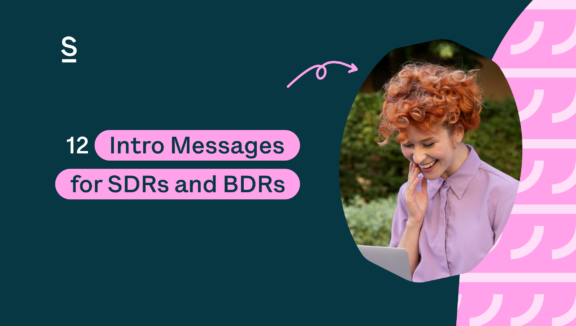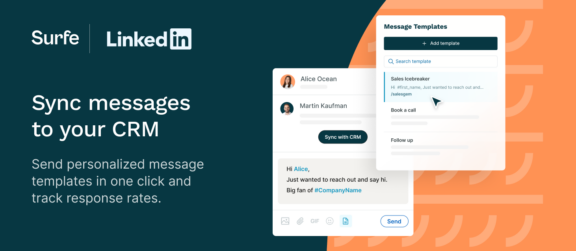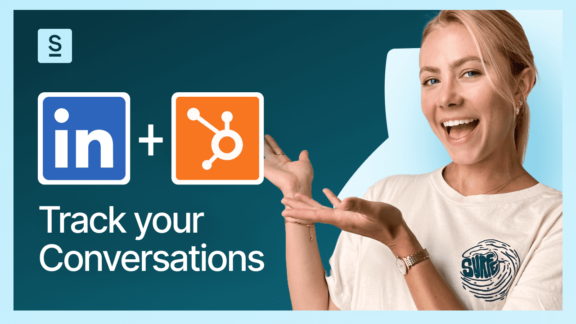12 LinkedIn Intro Message Templates that Convert

Remember the last time you waved at someone to get their attention, and they just…didn’t see you?
Ouch. Sends shivers down our spine just thinking about it.
Sending a LinkedIn Intro message that doesn’t get a response can feel a bit like that. But it’s not just a bit cringe – it also means you’ll have to work harder to get your prospect’s attention later down the line. Double ouch.
In an ideal world you’d make sure this never happened by working on a perfectly unique, tailored message for every single prospect. But in the real world you’re a sales rep with a million things to do and not enough hours in the day to fit everything in.
Fortunately, you’re also a smart sales rep – after all, you’re reading this blog post, which is going to share our tried and trusted LinkedIn intro message templates with you. They’re all easily adaptable for multiple audiences and outcomes – plus they balance personalization and automation, which we all know is the key to maximizing your sales efficiency.
Here’s what’s coming up:
- What is a LinkedIn Intro Message?
- Why is it Important to Get your LinkedIn Intro Messages Right?
- Our 12 free templates
Ready to write LinkedIn messages that convert? Of course you are. Keep reading.
What is a LinkedIn Intro Message?
Before we get into it, what is a LinkedIn intro message and why would you send one?
If you’re in the world of B2B sales, LinkedIn is an essential tool in your arsenal when it comes to prospecting and outreach. Sending a LinkedIn intro message is usually done as part of the outreach process, as part of a multi-channel, multi-touch outreach strategy.
As we’re about to show you, these messages can take many, many forms – but their ultimate goal is the same. A successful LinkedIn intro message will elicit a response from your prospect – ideally saying that yes, they’d love to meet for a call, but more probably asking for more information or responding to a question you asked. Basically, if your message manages to engage your prospect, you can consider your job well done.
Note: always make sure your LinkedIn messages are synced to your CRM with the Surfe Chrome extension!

Why is it Important to Get your LinkedIn Intro Messages Right?
LinkedIn intro messages are important to get right because first impressions are important. Simple. Put a foot wrong, and at best you’ll be working harder to impress your prospect from now on. At worst, you could annoy them or even lose your chances of working with them entirely.
When you’re crafting your intro messages for sales, we’d recommend keeping these key tips in mind:
- Personalization: tailored messages show you’ve taken the time to learn about the recipient and their specific needs and challenges. Addressing them by name and mentioning relevant details about their company or industry demonstrates a genuine interest and expertise. In other words, it makes them feel special – and we all like to feel special.
- Clarity: your message should be clear about why you’re reaching out. Confusion or fluff might cause your prospect to lose interest. Plus, trying to hide the fact that you’re trying to sell them something isn’t a good look. Be upfront.
- Relevance: highlighting how your product is going to help your recipient shows that you’ve done your research and you know what you’re talking about. It also grabs their attention and demonstrates the value you can bring from the get-go.
Ok, you’ve got the basics down. Time to get into the good stuff.
Top tip: Before we get onto the templates themselves, you’re going to need a way to inject them into your LinkedIn messages. Surfe allows you to build templates that contain personalized variables and then send them to your contacts in one click.
12 Free LinkedIn Message Templates
The Formal Intro
When to use a formal intro: this one is industry-dependent. Nobody wants to sound like a robot, but some industries call for more of a formal approach than others. Use your judgment – you want to come across as polite and respectful without losing every trace of humanity.
Dear #firstname, I hope this email finds you well. My name is [your name] and I represent [your company], a [describe what your product does]. I came across #companyname and was impressed by your approach to [mention something specific about their company or industry], which aligns with our commitment to [industry]. I would love to explore potential partnership opportunities with #companyname. Let’s schedule a brief call to discuss this possibility further.
The Informal, Friendly Intro
When to use an informal, friendly introduction: using this tone of voice works well for the majority of industries. It’s easier to establish a rapport with your reader, which is one of the six principles of persuasion. It’s also slightly soft-touch – notice there’s no direct CTA here.
Hey #firstname, I saw the [adjective] work #companyname is doing in [industry]. I work with [your company name], and we’re all about [briefly describe the value your company’s product or service brings to the reader’s industry]. I’m excited to follow you and keep up with your content.
The Short and Sweet Intro
Why you would use a short and sweet introduction: it’s sad but true – send a message that’s too long, and you run the risk of it not being read. People are busy. Send a message like this, and you show you 1) are honest and upfront 2) respect their time.
Hi #firstname, I’m [your name] from [your company], which specializes in [product or service], a game-changer for [industry] — interested in learning more?
The Long, Detailed Intro
When to use a long, detailed introduction: for a certain type of prospect, introductions you’ve clearly put thought into can work. As we’ve said, they do run the risk of not being read properly (you’ll want to include plenty of white space and make sure you’re not waffling) – but giving them all the info they need to know can elicit a response if your businesses are a good match.
Dear #firstname, my name is [your name], and I represent [your company name], which specializes in [describe your product or service as it relates to the reader]. I recently came across #companyname and was impressed by (feature of the company) for the [industry or area of interest].
Our [product or service] helps companies like yours [mention specific benefits or outcomes in combatting pain points].
Are you interested in learning more?
I’d be happy to set up a call to chat whenever it’s convenient for you.
The Explanatory Intro
Why you would use an explanatory introduction: here, you’re speaking directly to your prospects’ pain. It shows just how well you understand them and their industry, and that you can solve their problems – which gets to the root of the majority of B2B purchases.
Dear #firstname, I am reaching out because I know that [pain point 1 and pain point 2] are often faced in the [insert sector] industry. At [your company], we understand the importance of overcoming the obstacles with [pain point]. Our track record helps organizations like yours achieve [insert desired outcome].
The Question-Based Intro
Why you would use a question-based introduction: this is an easy, low-stakes way to get an answer from your prospect, as answering a question is less of a commitment than agreeing to a meeting or call. Plus, their answer should hopefully give you a steer for your next message. Win-win.
Dear #firstname, I’m writing from [your company] and I’d love to know your thoughts on how [solution] can reshape the future [industry-related goal]. How do you see integrating [solution] into your team’s existing strategies?
The Meeting Invite Intro
Why you would start with inviting someone to a meeting: whether it’s a digital coffee or a meal in person, an invite like this shows you’re willing to invest time and (probably) money in meeting your prospect. Give options to show genuine care for your recipient’s time.
Dear #firstname, In [industry], we commonly see [pain point 1 and/or pain point 2], yet [solution] is a key to streamlining processes. I’d love to invite you to [lunch, a meeting] and discuss the potential of [solution] in boosting your bottom line.
Would [day 1, time 1] or [day 2, time 2] work well for you?
The Value Proposition Intro
Why you would open with your business’s value proposition: here, you’re quickly and simply showing your prospect what your business does and how it can help them. You’ll notice that this template is short, with bullet points to make it digestible.
Hi #firstname, at [your company] we have been helping businesses like yours achieve remarkable success by [briefly mention how your product/service adds value].
Our services include:
- [feature 1 or reason to believe 1]
- [feature 2 or reason to believe 2]
The Challenge-Solution Intro
Why you would use a challenge-solution intro: open with a challenge you know your prospects face, and you’re directly speaking to their pain – before quickly swooping in and showing just how your solution can solve it. Empathy and relevance in one go – tick.
Hi #firstname, as a fellow professional in the [industry name] industry, I understand the challenges that come with [pain point 1], [pain point 2], and [pain point 3].
Our solution can help by:
- [Benefit or reason to believe 1]
- [Benefit or reason to believe 2]
The Storytelling Intro
Why you would share a success story as part of your introduction: remember those six principles of persuasion we mentioned earlier? Here’s your chance to hit another one: social proof. Briefly explain how you absolutely nailed results for another client, and you’ll create FOMO around your solution – which is a huge motivator in getting your client to get in touch.
Hi #firstname, Not too long ago, the [department] team at [company] faced challenges in reaching their target goals. Despite their best efforts, they struggled to [desired outcome 1] and [desired outcome 2], leading to missed opportunities. Adding our [your solution] to their processes helped [company] do a 180 turn and [describe a specific and measurable advantage or benefit].
The Personalized Intro
Why you would personalize an introduction based on research: this is an easy one – the more you can show you’ve done your homework, the more your prospect will feel like you know them already. Plus, it implies that you’re familiar with the ins and outs of your industry – flaunting your industry expert status, if you will.
Hi #firstname, I recently came across #companyname and am impressed by your team’s approach to [mention a recent achievement or industry-specific success]. As a fellow professional in the [name industry] industry, I understand the importance of staying ahead in a competitive market. I especially enjoyed learning about #companyname’s [attention or achievement in their industry]. Our [product] can enhance [recipient’s efforts/goal] — I would love the opportunity to show you how.
The Engagement-Based Intro
Why would you base your introduction based on engagement: we’ve saved a good one until last. Follow up on an interaction you’ve already had, and your chances of getting a response go through the roof. Why? Well, you’re showing you care about creating a real connection with your prospects. The more you can build rapport, the more your prospects will feel obliged to reply. Win.
Hi #firstname! We both replied to [mention the specific content or post] on LinkedIn. What did you like the most about the article? I especially enjoyed [highlight a primary benefit in the article related to the reader’s industry]. I’d love to connect and share how our [product or service] is helping other companies achieve [desired outcome in the industry].
Effective Messaging in 2024: Final Thoughts
Creating an effective LinkedIn intro message for each and every prospect may seem like an intimidating task – but it really doesn’t have to be. Use templates to scale your efforts without compromising on personalization, and you’ll have positive responses flying into your inbox in no time.
Clever you for reading this blog post. Now, time to go and put it all into practice.

Go forth and prosper
You’ve got everything you need to write a killer LinkedIn intro message. Need to save your favorite templates and track your results? Surfe can help with that – free of charge.
FAQs About Writing LinkedIn Intro Messages That Convert
What is a Good Intro Message on LinkedIn?
A good introductory message on LinkedIn can take many forms, but will want to follow these key principles:
- Personalization: show you understand your prospect, and they’ll be more likely to reciprocate. Use their name and company name at a minimum – on top of that, you want to be speaking to specific pain points and referencing relevant case studies.
- Clarity: don’t beat around the bush when it comes to your reasoning for reaching out. Everyone appreciates a message that’s honest and upfront.
- Relevance: be sure to quickly show why you’re reaching out, and exactly how your product can help to get a great response.
How to Write High-Converting LinkedIn Prospecting Messages?
If you want your messages on LinkedIn to convert, you need to choose a message format that’s most likely to get a response from your chosen prospect. For example, a more traditional industry might require a more formal first message, while a prospect who’s at C-suite or equivalent level will probably appreciate brevity. Choose accordingly, and try a new approach if you’re not getting results.
How to Professionally Message on LinkedIn?
To send a professional message on LinkedIn, you want to come across as polite but not overly robotic – showing a bit of humanity is important! Keep your topic strictly work-related, and be upfront about why you are reaching out. Make sure that you’re not being overbearing – a good rule of thumb is to be cheerfully persistent.
How to Write LinkedIn Messages That Actually Get Read?
If you want your LinkedIn messages to get read, follow these two principles:
- Keep them short: people are busy. If your message is short, to the point, and makes the most out of bullet points, it’s more likely to be read in full.
Highlight value: make it super easy to see why you can help your prospect. Don’t bury your value prop in loads of text – give it its own line, or use bullet points to make sure that your prospects’ eyes definitely land on it.



